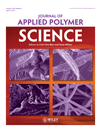Degradation and initiation polymerization mechanism of α-methylstyrene-containing macroinitiators
Abstract
Copolymers obtained from radical copolymerization of α-methylstyrene (AMS) and glycidyl methacrylate (GMA) behave as macroinitiators, when heated in the presence of a second monomer, giving rise to block copolymers. The relevant degradation and initiation polymerization mechanism of the macroinitiators were studied. Thermal depropagation of the macroinitiators generated monomers, identified by 1H-NMR, photoionization mass spectroscopy and FT-IR. According to the results of structure analysis by GPC, ESR and NMR spectroscopy, the AMS-GMA (head-head) and AMS-AMS (head-head) bonds in the macroinitiators are easily scissored providing free radicals when the temperature is above 80°C. The radicals lead to subsequent polymerization of the second monomer, and thereby block copolymers are formed. © 2010 Wiley Periodicals, Inc. J Appl Polym Sci, 2011




